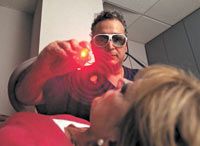New ancillaries tap the quest for youth
America's pursuit of youth and doctors' need to offer more services have created what could be an ideal opportunity for you.
Even the youngest members of the Forever Young generation-aka the Baby Boomers-are over 40, and many are fighting Father Time every step of the way.
The most affluent have long been enriching plastic surgeons, but new cosmetic products and devices have put skin rejuvenation and other aesthetic treatments within the reach of upper-middle-class and even middle-class consumers.
While some ob/gyns and primary-care doctors balk at expanding into cosmetic procedures, others see these new treatment realms as means of giving their practices a much-needed cash infusion. Indeed, in 2007, the number of surgical and nonsurgical cosmetic procedures performed on women topped 10.6 million, according to the American Society of Aesthetic Plastic Surgery. Women (and men) received 2,775,176 Botox injections. Laser hair removal accounted for 1,448,716 procedures, and 647,707 laser skin resurfacing procedures were performed.
What services should you go with? "Adding dermatology services to a primary-care practice as a means of augmenting income makes sense on a couple of levels," says Michael J. Parshall, a consultant with The Health Care Group in Plymouth Meeting, PA. "First, there's a shortage of dermatologists now, and second, many of these services are relatively inexpensive to set up and administer."

Services that patients pay for out of pocket rarely sell themselves, though, so Parshall recommends them only for physicians who are comfortable doing some marketing and have a certain amount of sales skill. In addition, careful work is needed before you get started, from determining patient interest in the service to gauging potential profitability to obtaining the training, personnel, and equipment needed to get the service up and running. Here's a look at how to do that for four ancillary services-facial fillers, vein therapy, weight-loss counseling, and therapeutic massage.
Deciding what service to offer
Don't set up a new ancillary service without first doing a feasibility study. There's no sense in launching a venture that your patients can't afford or aren't interested in. "Think of an ancillary service as a stand-alone business-not from a legal perspective, but from a planning perspective," says Michael J. Wiley of Healthcare Management and Consulting Services in Bay Shore, NY. "And as with any business, you want to estimate the anticipated expenses and income, as well as the time, effort, and volume you'll need to make the venture profitable."
Wiley recommends these steps:
"This is a diversion from your medical practice," says ob/gyn James Mirabile, who began offering cosmetic services in his Overland Park, KS, practice 10 years ago. "Go to a seminar, learn about the procedure you're considering, and assess whether it's something you're going to be comfortable providing."
FDA grants 510(k) clearance to chemiluminescence-based immunoassay
Published: January 10th 2025 | Updated: January 10th 2025The automated chemiluminescence-based immunoassay has received clearance for free testosterone, providing enhanced diagnostic options to a multitude of conditions.
Read More
